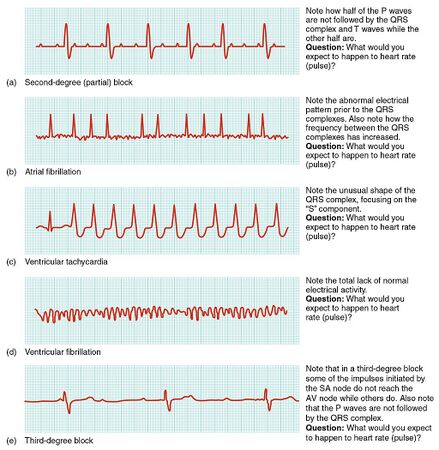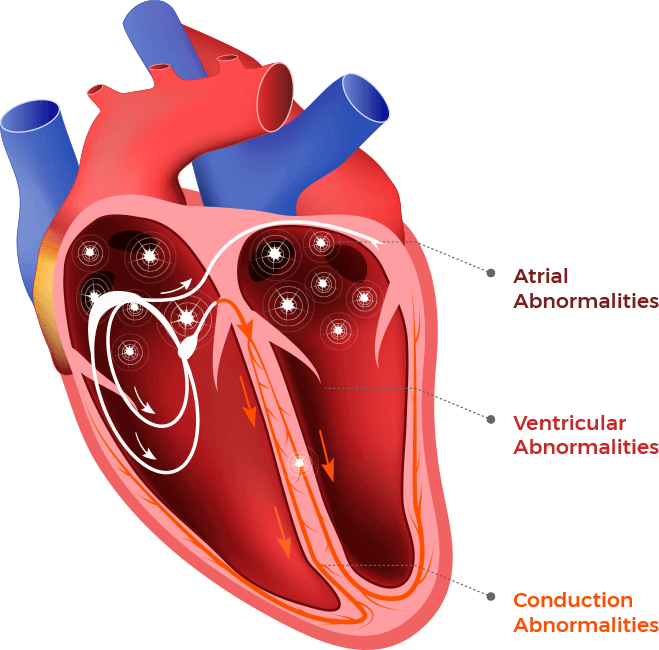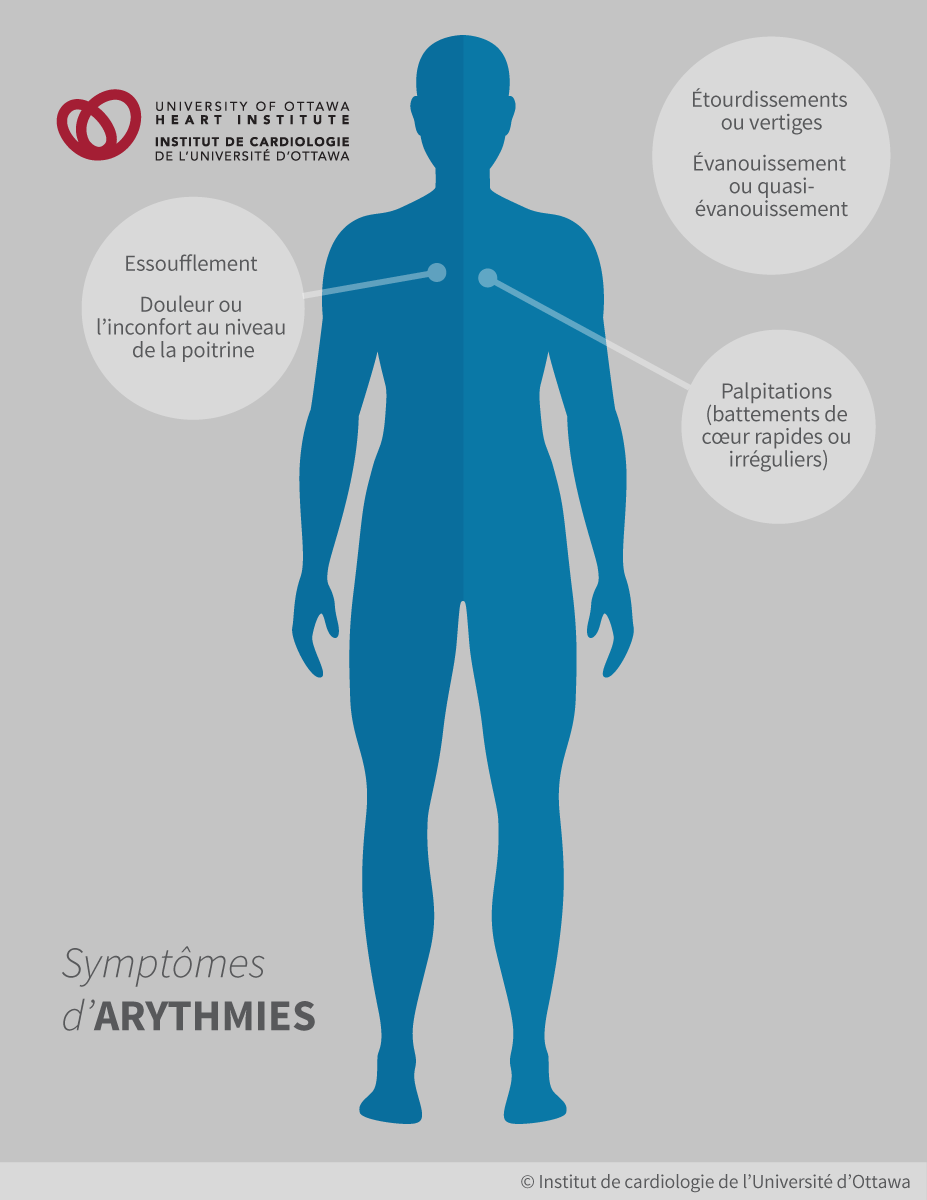What and Dysrhythmia Are Used to Describe Abnormal Heart Rhythm
During a dysrhythmia the heart can beat too fast too slowly or with an irregular rhythm. In this case a lack of normal rhythm.

Ventricular Arrhythmia Causes Symptoms Treatment
As occurs in high altitudes.

. The term arrhythmia is used to describe an abnormal heartbeatone that is too fast too slow or irregular. Term used to describe abnormal electrical activity in the heart causing irregular heart beat. Types include bradyarrhythmia or supraventricular arrhythmia.
Refers to an ECG that is within normal limits. ECG can accurately diagnose atrial fibrillation. The vagal stimulation of the parasympathetic nervous system can cause a decrease in the rate at the SA node and can also decrease the excitability of the AV junction fibers.
The term arrhythmia or sometimes dysrhythmia means an abnormal heartbeat. Meanwhile dys is. This is a heartbeat that has an abnormal speed or rhythm.
A common dysrhythmia that occurs when multiple irritable sites fire in the atria. Incision of a vein. It is used to describe a number of very well defined electrophysiological manifestations ranging from benign harmless conditions to severe life-threatening disturbances of the hearts rhythm.
The ability of the cardiac muscle to initiate an electrical impulse is called automaticity The ability of the cardiac muscle to transmit electrical impulses is called conductivity The term depolarization is used to describe the electrical stimulation of the heart. Inflammation of a vein with clots. Ventricular tachycardia Ventricular tachycardia is an abnormal heart rhythm that begins in the ventricles.
Ventricular Fibrillation V. Simple non-invasive test that records the hearts electrical activityThe ECG produces a printout that doctors can examine to diagnose arrhythmias or other types of heart disease. The ability of the cardiac muscle to initiate an electrical impulse is called automaticity.
V-tach is considered a life threatening dysrrhythmia because the rapid ventricular rate prevents adequate filling time for the heart leading to reduced cardiac output that often degenerates into ventricular fibrillation and cardiac arrest. When a heart beats too fast the condition is called tachycardia. A dysrhythmia sometimes called an arrhythmia occurs when there is a disturbance of the normal electrical conduction resulting in an abnormal heart muscle contraction or heart rate.
Dysrhythmias are abnormal heart rhythms that can be caused by a variety of factors including electrolyte imbalances cardiac abnormalities and medications. The a prefix in arrhythmia means a lack or an absence of something. Dysrhythmias Heart works to perfuse the body When heart does not work effectively as a pump perfusion to vital organs peripheral tissues impaired resulting in organ dysfunction Cardiac dysrhythmias abnormal rhythms of the hearts electrical system affecting its ability to effectively pump oxygenated blood throughout the body o Some.
When a heart beats too fast the condition is called tachycardia. It can last anywhere between a few seconds and a few hours. These impulses stimulate and coordinate atrial and ventricular myocardial contractions that.
Although pulse rates will vary from one person to another a normal resting heart rate is generally between 60 and 100 beats per minute with a regular rhythm. Considered controlled if the ventricular rate is under 100 and uncontrolled if the ventricular rate is over 100. Dysrhythmia and arrhythmia are both terms doctors use to describe an abnormal heart rate.
Carried out to check electrolytes and levels of thyroid functionsRisk of arrhythmias increases with an overactive. To reduce artifacts leads should be placed correctly and patients should be instructed to avoid movement during the exam. When a heart beats too slowly the condition is called bradycardia.
The term depolarization is used to describe the electrical stimulation of the heart. Contractions of the ventricles in an atrial fibrillation rhythm at a rate of 100 BPM or greater. Abnormal heart rhythms occur for several reasons.
Dysrhythmia is also known as arrhythmia which is a problem with the rate or rhythm of the heartbeat. When a heart beats too slowly the condition is called bradycardia. This condition is also sometimes referred to as dysrhythmia.
A-V block These types of dysrhythmia occur when there is an issue getting the heartbeat signal between the sinus node and the ventricles. The ability of the cardiac muscle to transmit electrical impulses is called conductivity. This causes a slowing of the heart rate and in severe cases a complete blockage of the impulse through the AV junction.
The term dysrhythmic is used to describe an irregular or erratic heart rhythm. All people have an occasional irregular contraction of the heart. During a dysrhythmia the heart can beat too fast too slowly or with an irregular rhythm.
Disorder of the formation or conduction or both of the electrical impulse within the heart altering the heart rate heart rhythm or both and potentially causing altered blood flow also referred to as arrhythmia dysrhythmias can cause. Surgical puncture of the membrane surrounding the heart to remove fluid. Cardiac Chapter 26 The term dysrhythmic is used to describe an irregular or erratic heart rhythm.
The hearts electrical wiring is one of the most sophisticated and. Dysrhythmia is also known as arrhythmia which is a problem with the rate or rhythm of the heartbeat. Condition of decreased oxygen in inspired air.
Arrhythmia or dysrhythmia are disturbances in the normal cardiac rhythm of the heart which occurs as a result of alterations within the conduction of electrical impulses. Terms in this set 78 dysrhythmia.

Heart Arrythmia Types Irregular Heartbeats In Dilated Cardiomyopathy


Comments
Post a Comment